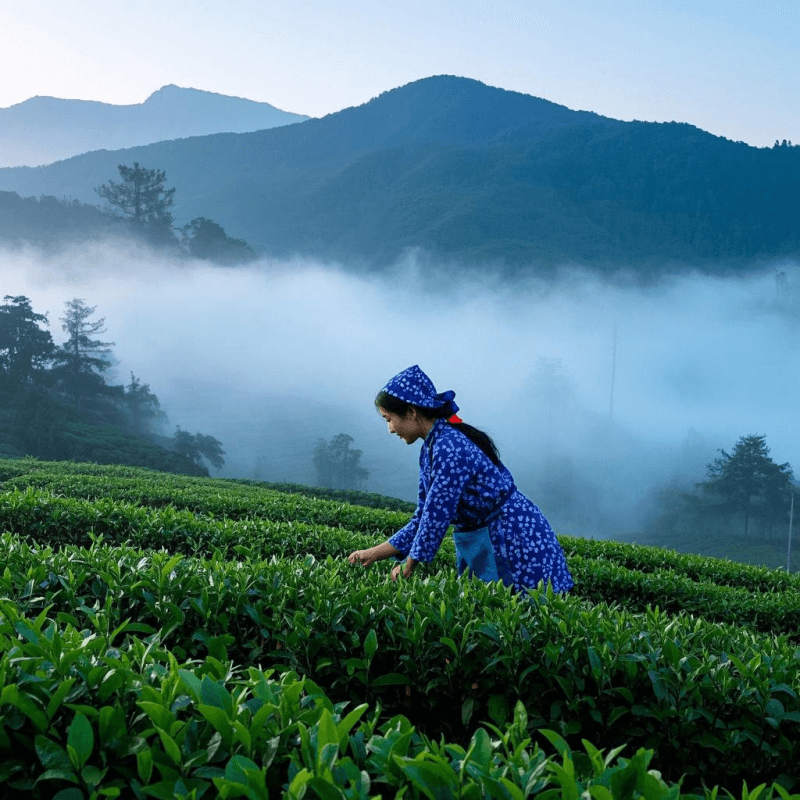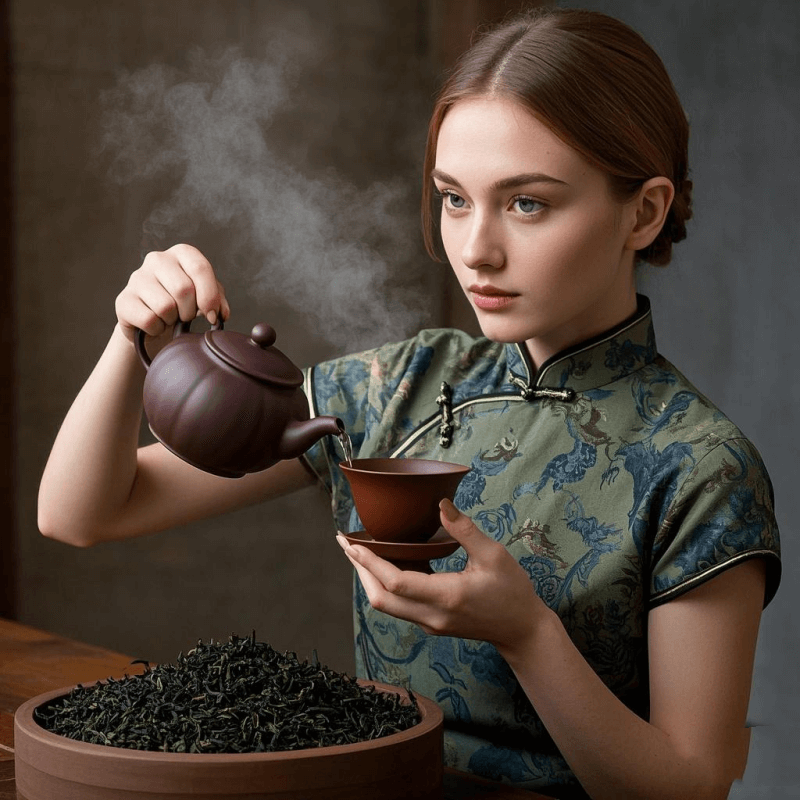
1. Introduction: Why Oolong Tea Flavor Deserves Closer Attention
The world of tea is a tapestry of flavors, but few threads are as captivating as those woven by oolong tea. Unlike the straightforward boldness of black tea or the grassy simplicity of green tea, oolong offers a symphony of tastes that dance between floral elegance, roasted richness, and fruity nuances. A 2023 survey by Tea Sage, a leading authority on tea culture, found that 72% of tea enthusiasts cite “exploring complex flavors” as their primary reason for choosing oolong, highlighting the growing curiosity around oolong tea flavor. Whether you’re sipping it in a traditional gongfu ceremony or enjoying a casual cup, understanding these flavor profiles can transform your appreciation of this semi-fermented wonder.
Oolong tea’s magic lies in its versatility. Grown in mist-shrouded mountains and ancient tea gardens, each batch carries the imprint of its terroir, processing method, and leaf variety. From the delicate aromas of Taiwanese high mountain oolongs to the smoky depth of Wuyi rock teas, every sip tells a story. In this guide, we’ll decode the complexities of oolong tea flavor, empowering you to choose the right brew and master the art of brewing to unlock its full potential.
2. What Is Oolong Tea? A Brief Introduction
Oolong tea is a semi-fermented tea that bridges the gap between green tea (minimally oxidized) and black tea (fully oxidized), with oxidation levels ranging from 8% to 85%. This middle ground gives it a unique chemical composition, balancing the freshness of green tea with the robustness of black tea. Originating in China’s Fujian province during the Ming Dynasty, oolong tea has evolved into a global phenomenon, with Taiwan, Vietnam, and even Australia now producing exceptional varieties.
The journey from leaf to cup is a meticulous process:
- Withering: Leaves are air-dried or sun-basked to reduce moisture and activate enzymes.
- Oxidation: Gently bruised or rolled to break cell walls, allowing controlled oxidation that develops flavor compounds.
- Firing/Baking: Heat halts oxidation, locking in flavor and aroma—roasting can add layers of complexity, from subtle toastiness to deep caramel notes.
This balance of science and artistry is why oolong tea flavor varies so widely, making it a favorite among those who seek depth and discovery in their cup. Ready to explore? Discover the subtle beauty of oolong tea with our premium leaves sourced from heritage farms that honor traditional craftsmanship.
3. Core Flavor Profiles of Oolong Tea: From Floral to Roasted
Oolong tea’s flavor spectrum can be divided into three main categories, each defined by its oxidation level and processing techniques:
Lightly Oxidized Oolongs (10–30% Oxidation): Delicate & Aromatic
These teas retain much of their natural green tea freshness but with gentle floral and fruity notes:
- Taiwanese High Mountain Oolong: Grown above 3,000 feet in Alishan and Lishan, this tea boasts a celestial oolong tea flavor—think jasmine blossoms, ripe lychee, and a crisp, honeyed finish. The cool mountain air and misty climate slow leaf growth, concentrating sugars and aromatic compounds.
- Anxi Tie Guan Yin (Traditional Style): A Fujian classic with 20–25% oxidation, offering orchid fragrance, citrus zest, and a creamy mouthfeel. Modern low-oxidation versions are brighter and greener, while traditionally roasted styles have subtle nutty undertones.
Moderately Oxidized Oolongs (30–60% Oxidation): Balanced & Complex
Here, oxidation introduces deeper layers without overwhelming the palate:
- Phoenix Dan Cong Oolong: Hailing from Guangdong’s Phoenix Mountains, these “single bush” teas are famous for their extreme flavor diversity. Varieties like Mi Lan Xiang (Honey Orchid) blend floral elegance with honey sweetness, while Da Wu Ye offers bold notes of ripe mango and cinnamon spice.
- Wuyi Shui Xian: A robust yet smooth oolong with 40–50% oxidation, featuring dried fig, roasted chestnut, and a subtle smokiness from charcoal roasting. The large Shui Xian leaves absorb flavor slowly, revealing new nuances over multiple steeps.
Highly Oxidized Oolongs (60–85% Oxidation): Bold & Roasted
These teas embrace full oxidation and heavy roasting, ideal for those who crave intensity:
- Wuyi Rock Tea (Da Hong Pao): Known as the “King of Oolongs,” this tea has a deep, rocky flavor (“yan yun” or “rock rhyme”) with notes of dark chocolate, tobacco, and baked plums. The unique red sandstone soil of Wuyi Mountains imparts a mineral-rich backbone.
- Bai Hao Oolong (Oriental Beauty): A Taiwanese specialty bitten by leafhoppers, triggering natural oxidation that creates a luscious, honeyed flavor with notes of apricot jam and rose petals. Its bold sweetness pairs perfectly with desserts or afternoon snacks.
As tea expert Kevin Gascoyne notes in The Tea Enthusiast’s Handbook, “Oolong tea flavor is a journey—each steep reveals a new chapter, from the first bright sip to the lingering finish that invites you back for more.”
4. Factors That Shape the Oolong Tea Flavor
Three key elements determine how an oolong will taste, making each batch a unique expression of its origin and craft:
1. Terroir: The Taste of Place
- Soil: Rocky Wuyi soil adds minerality; Taiwan’s fertile, acidic earth fosters floral sweetness; while India’s Darjeeling region imparts a muscatel-like aroma to its oolongs.
- Altitude & Climate: High-altitude teas (e.g., Taiwan’s Lishan) develop delicate, nuanced flavors due to slow growth, while low-altitude varieties (e.g., some Fujian oolongs) can be more robust and earthy.
2. Processing Techniques
- Oxidation Level: As discussed, this is the primary driver of flavor—lower oxidation for freshness, higher for depth.
- Roasting: Light roasting (1–2 hours at 120°C) adds subtle toastiness; heavy roasting (4–6 hours at 160°C) creates caramelized, smoky notes. Some teas, like Wuyi Rock Tea, are roasted multiple times to develop “hui gan” (returning sweetness).
- Leaf Handling: Hand-rolling versus machine-rolling affects how flavors are released—hand-rolled teas often have more complex textures.
3. Leaf Variety
- Small-leaf cultivars (e.g., Tie Guan Yin, Qilan) produce fragrant, delicate oolongs.
- Large-leaf cultivars (e.g., Shui Xian, Bai Ye) yield full-bodied, robust flavors.
- Hybrid varieties (e.g., Taiwan’s Jinxuan #12) offer balanced profiles, like milk oolong’s creamy, coconut-like sweetness.
5. Regional Differences in Oolong Tea Flavor

Oolong’s flavor diversity is deeply rooted in its birthplaces, each region offering distinct terroir and craftsmanship:
China: The Cradle of Oolong
- Fujian Province:
- Wuyi Mountains: Home to rock oolongs (Da Hong Pao, Shui Jin Gui) with bold, roasted, and mineral-driven flavors.
- Anxi County: The birthplace of Tie Guan Yin, producing both light, floral modern styles and traditionally roasted, complex versions.
- Guangdong Province:
- Phoenix Mountains: Renowned for Dan Cong oolongs, each named for its unique flavor (e.g., Yu Lan Xiang = Magnolia Fragrance, Bai Na Xiang = Banana Flavor).
Taiwan: The High-Altitude Innovator
- Alishan & Lishan: Produce some of the world’s most sought-after oolongs, characterized by bright floral notes, tropical fruit, and a crisp, clean finish.
- Nantou County: Known for aged oolongs and bold, roasted teas like Dong Ding, which balances caramel sweetness with a slight astringency.
Beyond Asia: Emerging Terroirs
- Hawaii: Volcanic soil gives local oolongs a unique earthy-sweet flavor.
- Kenya: High-altitude gardens produce oolongs with citrus and berry notes, appealing to Western palates.
6. How to Brew Oolong Tea to Enhance Its Flavor
Brewing is the final act in the oolong tea flavor story—get it right, and you’ll unlock layers of taste:
1. Water Quality & Temperature
- Water: Use filtered or spring water; avoid chlorinated tap water, which can dull flavors.
- Temperature:
- Light oolongs (e.g., Taiwanese High Mountain): 185°F (85°C) to preserve floral aromas.
- Moderate/high oolongs (e.g., Dan Cong, Wuyi): 195–205°F (90–96°C) to extract complex flavors.
- Heavily roasted oolongs (e.g., Da Hong Pao): Boiling (212°F/100°C) to activate roasted notes.
2. Leaf Quantity & Steeping Time
- Loose-leaf ratio: 1–1.5 tsp (5–7g) per 6 oz (180ml) for gongfu brewing; 1 tsp per 8 oz for Western-style.
- Steeping time:
- First steep: 20–30 seconds (light oolongs) or 30–45 seconds (roasted oolongs).
- Subsequent steeps: Increase by 10–15 seconds each time—oolong can be steeped 5–10 times, with flavors evolving from bright to mellow.
3. Brewing Vessels
- Gongfu cha (Chinese tea ceremony): Use a gaiwan (lidded bowl) or Yixing clay pot to concentrate aroma and flavor. Elevate your tea experience with authentic oolong teaware designed to enhance every steep.
- Western-style: A glass teapot lets you watch the leaves unfurl, while an infuser makes casual brewing easy.
4. Pro Tips
- Rinse lightly oxidized teas for 5 seconds to remove dust and wake up the leaves; roasted oolongs benefit from a quick rinse to open up their flavors.
- Store properly: Keep oolongs in airtight tins away from light and moisture—roasted varieties can age gracefully, developing deeper flavors over time.
7. Conclusion: Savoring the Complexity of Oolong Tea Flavor
Oolong tea is more than a beverage; it’s a journey through flavor, culture, and craftsmanship. From the floral whispers of a high mountain oolong to the bold roasty notes of a Wuyi rock tea, each cup invites you to slow down and explore. By understanding the factors that shape oolong tea flavor—terroir, processing, and brewing—you’ll gain the confidence to choose teas that resonate with your palate and master techniques to enjoy them fully.
Ready to embark on your flavor adventure? Browse our oolong tea collection for every taste preference, from delicate floral varieties to robust roasted gems. And when you’re ready to brew, savor the taste of oolong tea with traditional brewing tools that honor its complexity. Whether you’re a beginner or a connoisseur, every sip of oolong is an opportunity to discover something new—a testament to why this tea has captivated drinkers for centuries.
Meta Description:
Uncover the diverse oolong tea flavor profiles and learn how to brew them to perfection. From floral to roasted, explore what makes each cup a unique sensory experience. 🍵

Pingback: Brew Bigelow Oolong Tea Like a Pro: Your Guide to the Perfect Cup